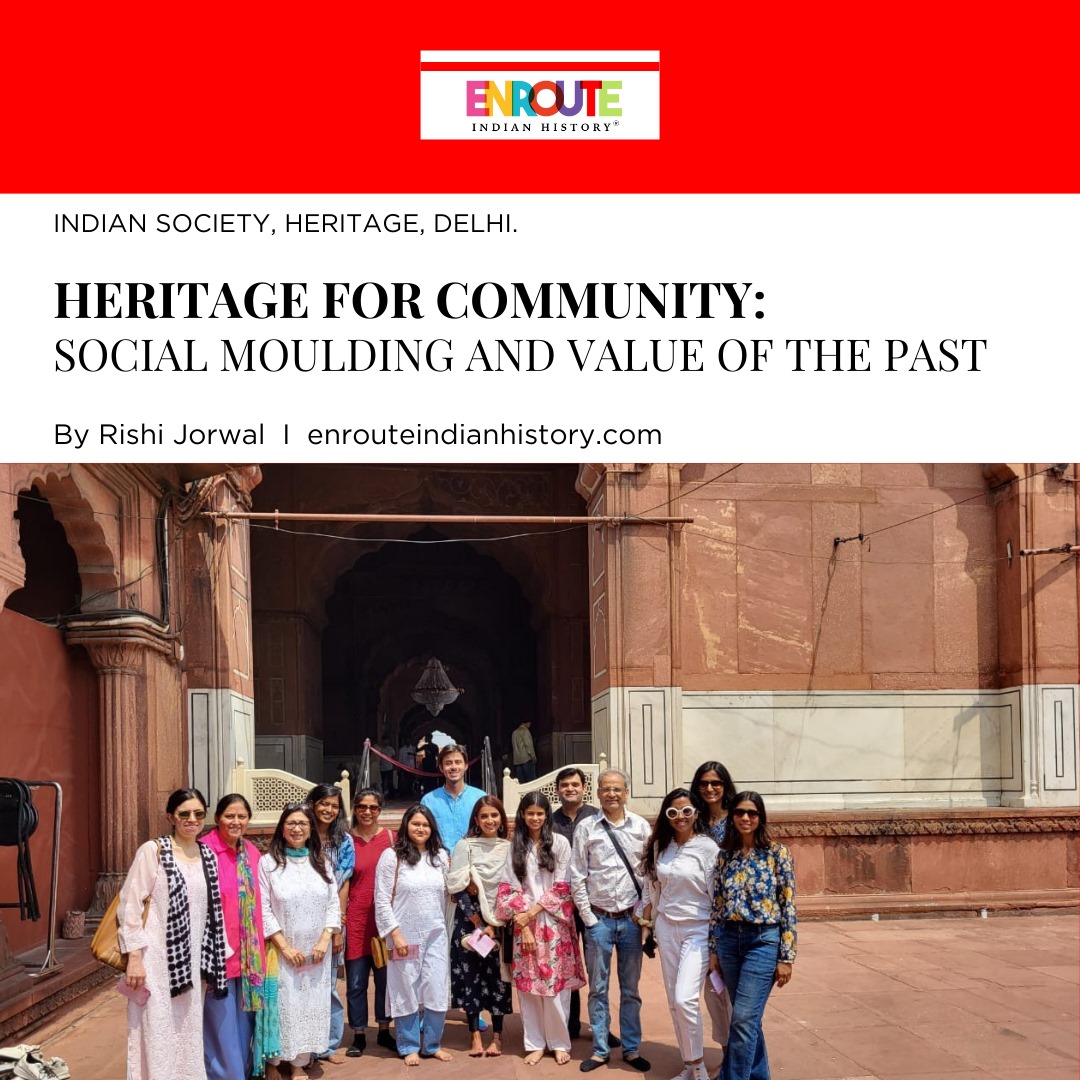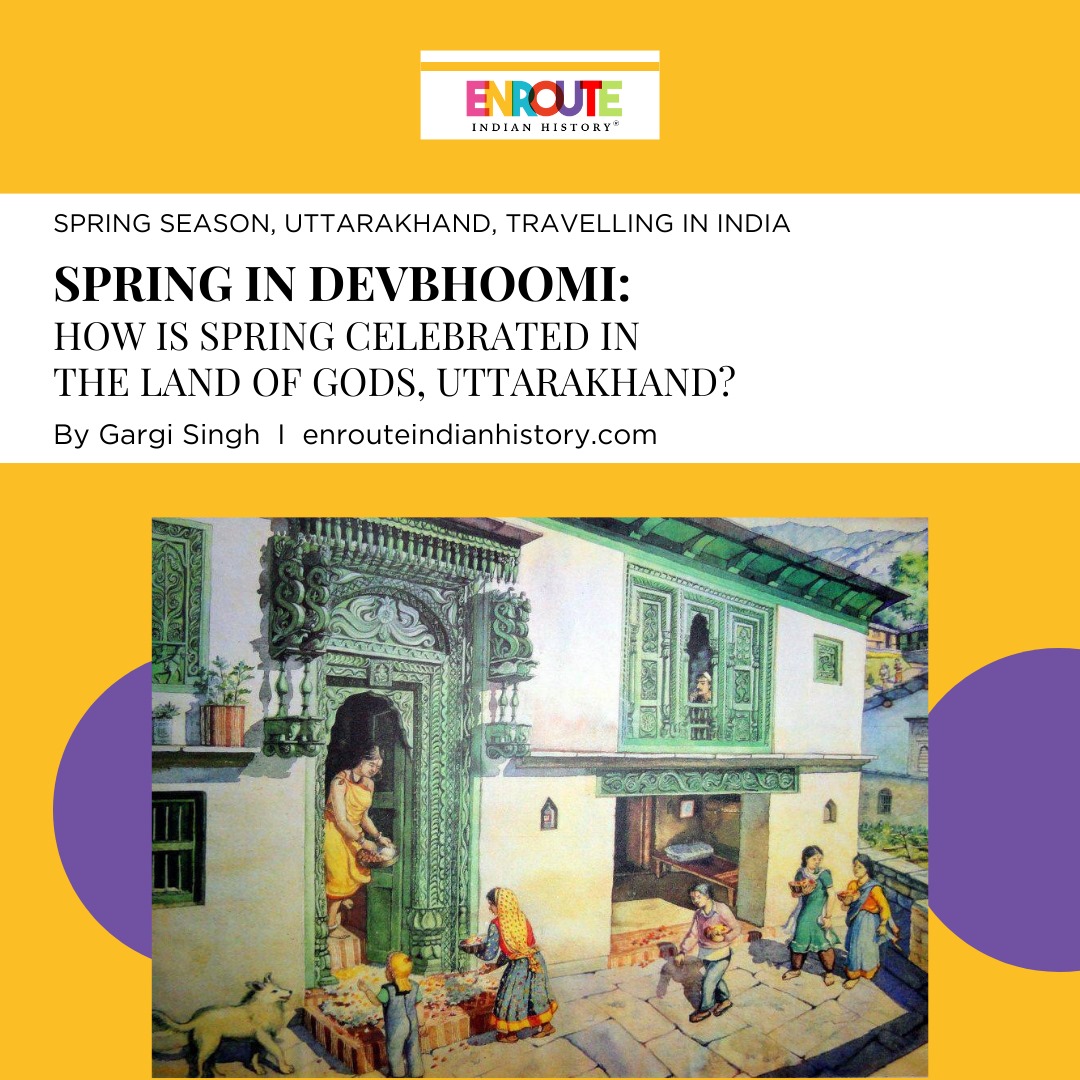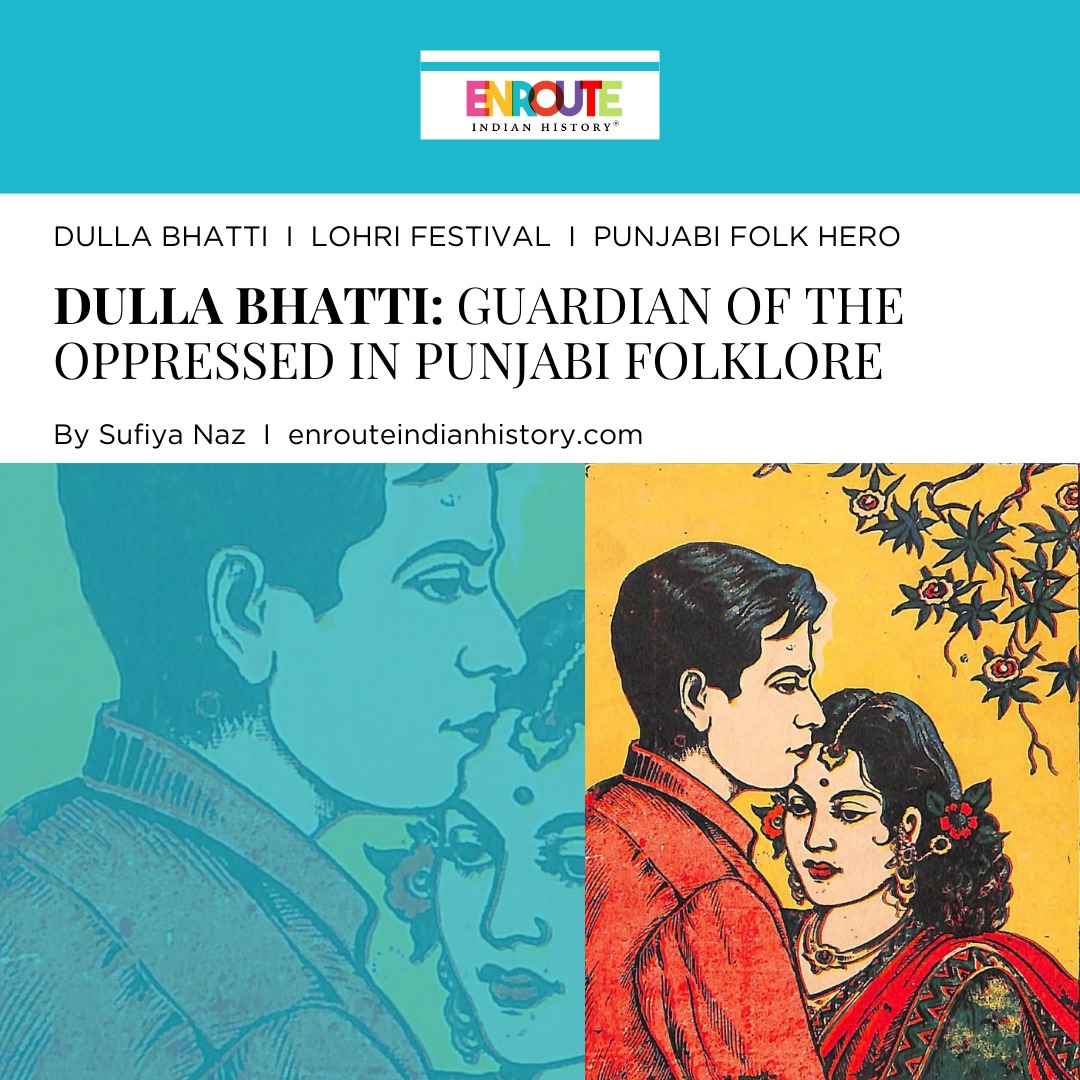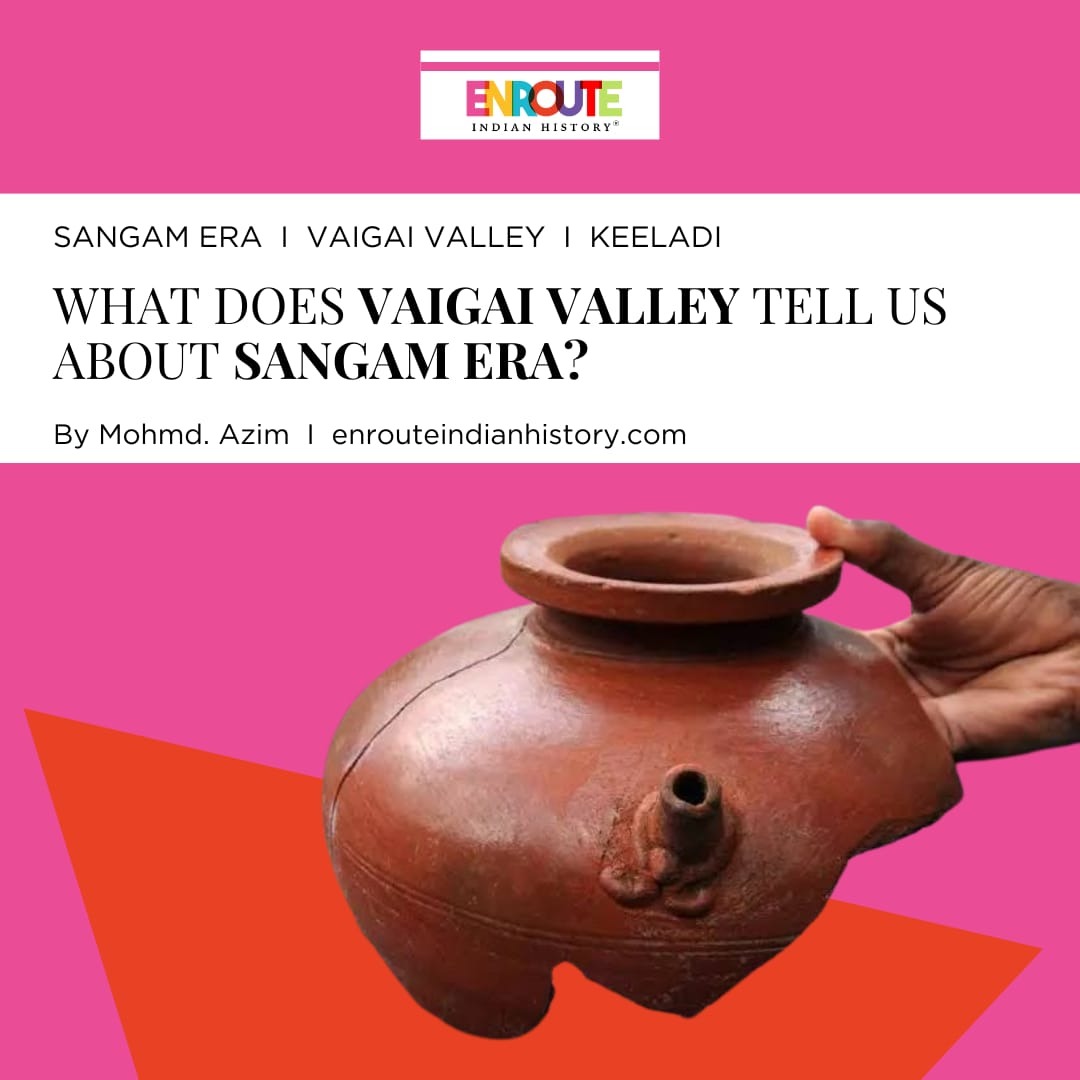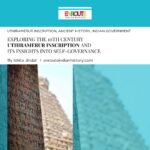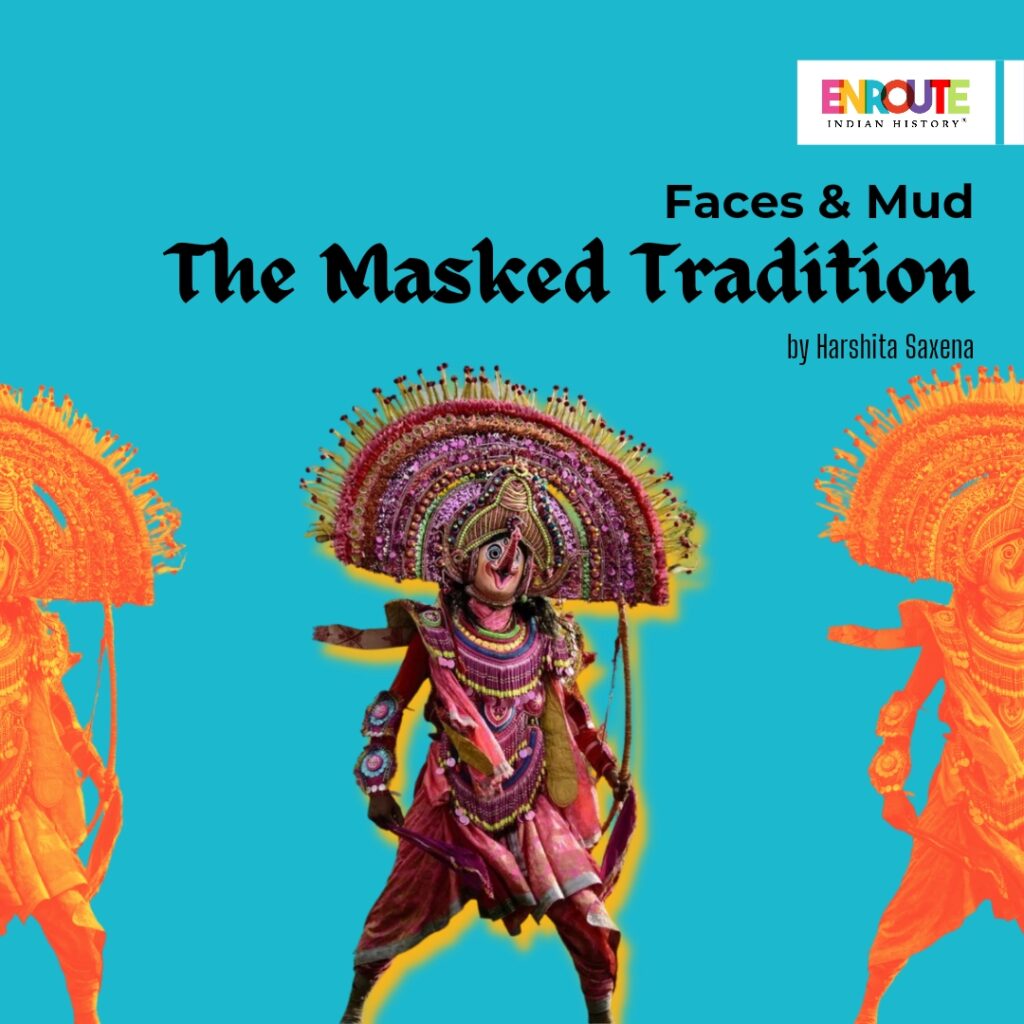
Background & Genesis: Masks & Mud or Terracotta
The word ‘mask’ appeared in English in the 1530s from the French ‘masque’ which means to conceal or shield the face. Masks were an aesthetic creation of man, employed in dance rituals, dramas, folk songs, temples, and different socio-cultural contexts. It is usually worn over or in front of the face; sometimes however a mask covers almost the whole body of the wearer.
Materials like bamboo, cane, clay/mud, cloth, metal, paper, wood, etcwere among some commonly used mediums to make masks. Usually, the masks were made from perishable materials by the artisans, thus artifactual evidence of the same remains scanty, especially in India. The leaves might have been used as the first material in the making of masks in ancient times, but in later age clay/mud and wood were used, followed by cloth and paper mache.
Craft of Mask-Making: Terracotta Masks and its Evolution
B.M. Pande in “Mind, Man and Mask”(2001) points out that there is evidence in the Mesolithic and Upper Paleolithic cave paintings of Central India that masks have been used in South Asia since 15000 BCE, or earlier. It included dancing figures-dances of exorcism and renewal- with some wearing animal masks and carrying bows and arrows, while others adorned more abstract masks that appear in the rock art of Bhimbetka.

Bhimbetka Upper Paleolithic cave painting of men wearing mask
Ensuingly, during the Indus Valley Civilisation (IVC), the excavations yielded abundant objects in terracotta. Terracotta or baked clay has served as an important material to transmit expressions of creativity and socio-economic dynamics. It is usually made from a fairly coarse, porous type of clay/mud. This is first sculpted, then fired until hard. In ancient times, it was left to harden in the hot sun; and in later period it was baked in primitive ovens created in the ashes of open fires. Terracotta art thrived chiefly because the easy availability and softness of clay/mud provided quick molding and preparation of figurines, by the artisans, in the desired shape and size, giving weightage to mass production and easy transportation. A.Srivastava and V.Tripathi (1994) suggest that it was the ‘molding technique’ of the terracottas that were used to produce masks. These masks, hollow at the back, were positively made in a mold, most probably wooden molds.

Terracotta mask from Mohenjo-daro
Interestingly, the remains found from IVC are all miniature terracotta masks, and not life-size. The evidence from Mohenjo-daro suggests that there were four types of masks- short-horned grotesquely human-faced; horned panther-faced; bull-faced; and bull-horned, bearded human-faced. The seal with the figure of Pashupati reveals the evidence of a mask of the combined figure of both animal and human form. These were all revered as deities. The next known evidence is from the NBPW (Northern Black Pottery Ware) sites of Chirand. A life-sized mask, having a ‘fierce-looking human face with protruding teeth, bulging nose, rounded eyes, and applied moustache.’
Ritual Significance of Masks In Indian Tradition
Across human civilization, there are two types of masks- one that is based on an individual’s imagination, like that of demons, deities, and ancestors; two that is based on morphological features like anthropomorphic (human features) and theriomorphic (animal features). These various kinds of masks allow us to reflect on the multiple worlds we inhabit. The masks include socio-religious, festive, theatrical, funerary, commemorative, therapeutic, exorcism, harvesting, hunting, victory purposes, and others.
Elaborate rituals and ceremonies are observed in the making, preservation, and disposal of masks. Ritual worship and taboos of various kinds are observed throughout the process of making masks. Usually, the artisans and wearers are not allowed to eat certain types of food, consume alcohol, have sexual intercourse, etc. for a prescribed period before and during the performance. However, the most sacred and important ceremony is the last act where life in the mask is infused by the maker through a ritual called “opening the eyes” on its completion. This ritual not only imparts life to the mask but also strengthens its magical powers and ritual efficacy. The masks are either preserved at a sacred place near/ inside the temple or shrine or are destroyed immediately after the performance.
The most important aspect is the facial expression, painted according to the context. Some of the facial expressions are taken as a sign of vulgarity and bad manners of a person. Moreover, an expression accepted in a particular situation like in a marriage ceremony, is not accepted in a mortuary rite or some other rituals. There are rumours about how the artisans were harassed by demons and deities for neglecting the traditional structures.
Essentially, masks were revered and fell within the ambiance of religious codes- ‘folk religion’, ‘devi and devas’, or demi-gods of Hinduism. Masks of Siva and Durga and especially the three-eyed Shakti, remained one of the most powerful iconic masks in India. In Andhra Pradesh, the Narasimha icon in the Bhagavata Mela is very popular. Mythological and real animals- be it the lion mask of Purulia or the Jackal mask from Gambhira- remain a powerful facet of folk religion and occupy a sacred space in Indian culture.
Terracotta Masked Dance Festival: A Case Study
The masked dance has its origin in a realm where deep mystical and ecstatic experience can spit the consciousness of the human self but molds his spiritual part into a new existence. That is why the dancer acts and talks like the spirit that the mask represents. It is very much similar to the recent famous episode of ‘panjurli’ ‘possessing’ the devotee, that caught our attention in the Kannada movie ‘Kantara’. Thus, the genesis of dance in India is in religion. The earlier form of Bharatanatyam was performed by the devadasis as a votive offering to God. Even today, the dance dramas continue to be stories from the Mahabharata, Ramayana, and the Puranas, giving masks a ritualistic function.
The famous Chhau dance originated in the Purulia district of West Bengal.
The word Chhau means ‘chhaya’ (mask or shadow) according to ancient Sanskrit texts. Folklore credits the worship of Lord Shiva, as a driving force for the movement, where men used to put on makeup to portray Him followed by a Tandava style of dance. The mask came much later, which is now an intrinsic part of the dance. Initially, the masks were made of wood and eventually, clay/mud was used.
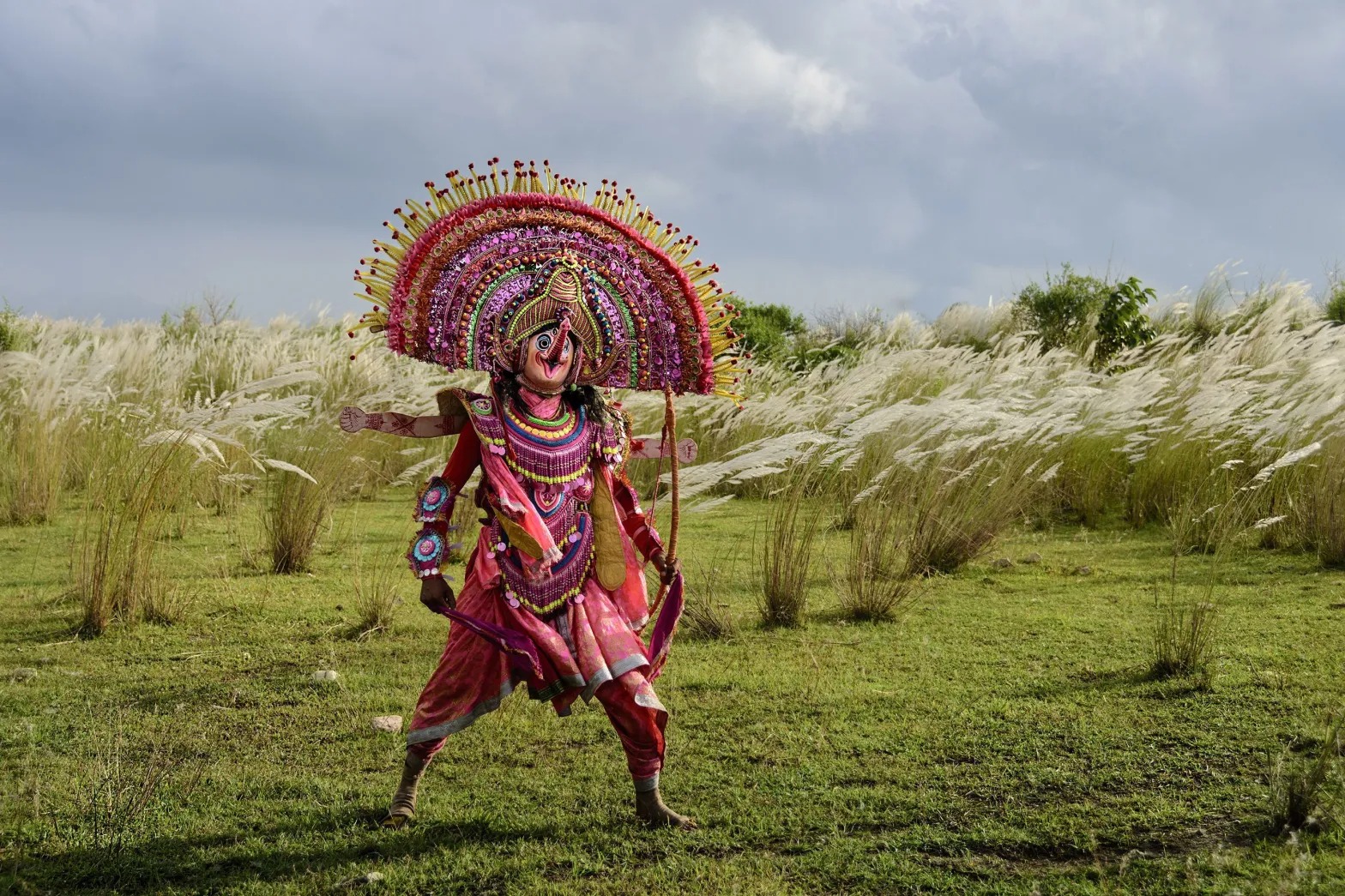
A still from the dance performance of Purulia Chhau
Photograph By Sarmishtha Bera, National Geographic Your Shot
Purulia Chhau is a vigorous combination of martial dance forms, and acrobatics interspersed with rhythmic bird-like movements, vibrant costumes, and amazing masks. Its dance technique is essentially an expression of the intimacy between man and nature. The performance depicts the episodes from the Mahabharata, the Ramayana, and the Puranas along with Shaivism, Shakti, and Vaishnavism as other themes. Chhau dance is intrinsically connected to the spring regional festival Chaitra Parva, where the dance is performed at night in an open ground to traditional and folk melodies, played on the reed pipes Mohuri and Shehnai. It is the Santhal community that drives the movement as a preferred form of entertainment, along with cock fighting and other feasting. The dance is traditionally an all males troupe, from families of traditional artisans or local communities.
In the small town of Charida, live the Chhau mask makers. Most people know the dance form, but the craft of mask making, combined with intricate grand headgear that weighs up to 5 kgs- is what deports the dancers and audience into a world of epic stories. There are approx 1200 mask makers in Charida village and Purulia town who work as an intrinsic part of dancer groups. It was Buddeshwar who popularized the mask-making tradition in Charida. The first male and female masks that he made were named Kirat and Kiratani, representing Shiva and Parvati.
The process of mask-making is laborious and wondrous and follows a series of steps to assemble a dancer’s awe-inspiring mask. It begins by covering a layer of clay over a stone mold which is in the shape of the face of the character, over which two sheets of used notebook paper are glued and smoothened. Another slightly thicker layer of clay is then added and smoothed over again. There are varied spoons/ spatulas of different shapes and sizes that are used to lay the clay over the surface. The final surface of the clay mask has to be carefully prepared to make it suitable for painting. Facial features like bared teeth, a prominent nose, or horns need extra bits of clay added on. While making a traditional clay mask, the face of each figure is chiseled very meticulously to enhance its beauty. After the sides are chiseled, strong facial features are carefully carved into the still-soft clay with a palette knife. Once the masks are dried, the artisan paints the mask according to a particular character- a woman, a demon, a god or goddess, or an animal. Often the animal (a tiger, lion, or deer) is covered with a layer of colored gauze to give it a rough texture and an authentic look. The hair is made from natural jute, and after dying it is black or brown as per the need. Then the masks are adorned with accessories and other jewelry and costumes.
Relevance in Today’s Age
We must remember that mask-making does not provide economic viability to the mask makers. With industrialization and better mechanical techniques, traditional art forms have been registering a declining trend, though not vanishing. The newer generation, however, is not enthusiastically taking arts and crafts as their first choice of livelihood, but some substantial families train the next generations to continue the Indian tradition. Mask making is potentially a male job; however, women are not tabooed from making it. The craft could use more hands, with more involvement of the female demography.
REFERENCES
Books
- Ghosh, A. An Encyclopaedia of Indian Archaeology. Munshiram Manoharlal Publishers Pvt. Ltd.,1989.pp 182-183.
Articles
- “Masks of Heritage”. https://www.academia.edu/36547655/MASKS_OF_HERITAGE
- Zaman, Arifur and Medhi, Birinchi K. “Tradition of Mask Making in a Vaishnavite Monastery of Assam, India.”
- Pandey, Anjali. “ Mask: A Creative Representation of Functional Art.”International Journal Of Research, Vol 7, 2019.
- “Akhyan: A Celebration of Masks, Puppets and Picture Showmen Traditions of India” Indira Gandhi National Centre for the Arts, 2010
- Pollock, Donald. “Maks and the Semiotics of Identity.”https://www.jstor.org/stable/3034576?seq=2
- Sharma, Riya. “A Study of Terracotta Bull Figurine of Harappan Sites in Rajasthan (Indian Context)” https://www.jstor.org/stable/b4367d08-4be4-3975-aaac-020bb4b6aba7?read-now=1&seq=2
- Kothari, Sunil. “The Use of Masks in Indian Dances and Dance-Dramas.” https://www.jstor.org/stable/43560654
Websites
- Masks, Other Worlds — Google Arts & Culture
- The Tribal World of Mask Makers in Bengal — Google Arts & Culture
- The Many Faces of Purulia Masks — Google Arts & Culture
- https://artsandculture.google.com/story/MAUhwJA_Ix8oLg?hl=en
- The Craft of Accessorizing for Chhau Dancers — Google Arts & Culture
- Purulia Chhau | INDIAN CULTURE.
- Chhau Dance : A folk dance of Purulia in West Bengal
Images
- Image 1: https://www.dollsofindia.com/library/mask/#:~:text=
- Image 2: https://www.google.com/url?sa=i&url=https%3A%2F%2Fwww.bradshawfoundation.com%2Findia%2Fcentral_india%2Findex.php&psig=AOvVaw3MaM__SY2WEGR_l1micHOY&ust=1690690253490000&source=images&cd=vfe&opi=89978449&ved=0CBEQjRxqFwoTCPiY5ZGGs4ADFQAAAAAdAAAAABAR
- Image 3: https://www.harappa.com/slide/mask
- Image 4: http://indianculture.gov.in/museums/pashupati-seal
- Image 5: https://www.google.com/url?sa=i&url=https%3A%2F%2Fwww.puruliachau.com%2F&psig=AOvVaw2VagEn1i0JdsdY9lIIjqul&ust=1690714498237000&source=images&cd=vfe&opi=89978449&ved=0CAQQjB1qFwoTCMjpv7rgs4ADFQAAAAAdAAAAABAY
- Image 6: https://www.dollsofindia.com/product/devi-durga-chhau-dance-mask-papier-mache-craft-SP51.html
- Image 7: https://www.google.com/url?sa=i&url=https%3A%2F%2Fwww.filmcompanion.in%2Ffeatures%2Findepth-stories%2Fkantara-and-its-vanishing-heroes&psig=AOvVaw0YjWLNAi5fdGPhdvWSjrrh&ust=1690716783247000&source=images&cd=vfe&opi=89978449&ved=0CBEQjRxqFwoTCKjd-_vos4ADFQAAAAAdAAAAABAw
- Image 8: https://mapacademy.io/article/chhau/
- Image 9: https://encrypted-tbn0.gstatic.com/images?q=tbn:ANd9GcSoEj6_RnDavCAT9lNhHMZCoSAuk8un9CSqxHOpo1q70m8BvV2zZolA_HlPD3ve23q-9ZM&usqp=CAU
- Image 10: https://encrypted-tbn0.gstatic.com/images?q=tbn:ANd9GcQcZqyXJPCaMVVjsbh7X1Jn3k6bOVZetu_CyO5X4ejh1N_ef2uOdudxVnB4y4iiLMBronY&usqp=CAU
- Image 11: https://shop.gaatha.com/handmade-chhau-mask-Durga-small
- April 18, 2024
- 5 Min Read
- January 17, 2024
- 10 Min Read


